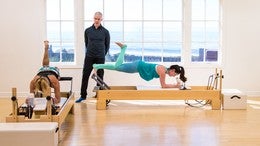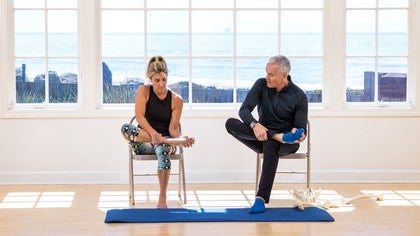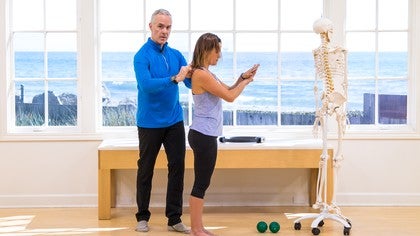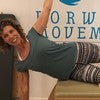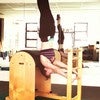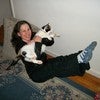Description
About This Video
Transcript
Read Full Transcript
Hi, I'm Tom McCook. I'm here with Christy epiglottis anytime and we're going to do a lesson, a tutorial on the foot to help you squat better, move better through space, and just get a sense of how the foot's designed to absorb and transfer energy. Foot's pretty cool deal. So let's take a look at it. So here you have the foot and the foot has 26 bones. Your heel, your Talus, that's right where your lower leg bone sits on top of right in front of that, you have your navicular, the high point of your arch, right next to that you have your cuboid, then you have three cuneiform bones.
That's kind of like the keystone of your arch, five metatarsal [inaudible] and 14 phalanges. So we're going to get a sense of the two key joints that need to move well to absorb force in the body or in the foot. And that's what's called the transverse tarsal joint. That's a line that goes in front of your talents and your heel. And that one, we want that to move in law, the forefoot to twist.
So then we have on the underside of the Talus, you have one called the sub tailored joint between your heel and the Talus. And it has several joint surfaces. It's a pretty complicated joint and the bones are pretty cool. This is actually the Talus is my favorite going in the body. It's really pretty neat guy. So if you think of its surface area, they give the whole, your whole body weight is upright on that small surface. So if there's any little deviations at that level, it's going to affect everything up the chain.
So we want to get these two to move wells so you can absorb force well and put less wear and tear on the body. So we're going to start with a little movement of twisting the foot. So Christy and I are going to cross our right foot over our left knee. We had to take hold of the heel with the left hand and the forefoot with the right hand. So here's the foot. So we're gonna call the in the heel. We're going to twist the forefoot back and forth, getting all the joints to move.
But we're going to put our focus on the transverse tarsal right there in front of the ankle, so she's just going to take and just twist or forefoot back and forth. Heel is staying relatively still. What this shows you is that your forefoot is designed to move quite a bit when the heel is, is it moving? That's the foot can adapt to the ground because you know, we, other than modern society, we lived on very uneven surfaces and our foot was designed to adapt for balance, locomotion, force absorption, all of those things. Now she's going to hold the forefoot, leave it still take the heel. Now she's gonna move the sub Taylor joint, the one that's underneath the Talus.
Just try to get it to move by pulling the heel towards her and then pushing it away. There we go. And just, you know, in the beginning if you feel like, God, I didn't know that was supposed to move, you know, just just get a sense that you don't have to be rigid in your shoulders or your neck. You can just Kinda, okay, I'm going to get that guy to move a little bit like it's been, it's like a jar that's been sticky. And now from there we're going to take, and we're going to counter, so we'll do both together. So it's just going to pull the heel towards us, turn the forefoot away and then reverse. That's it. And this is activating that design, putting the spring back so you can think of in your body, the energy currency of your body is the last two city. So your body transfers for three-dimensionally from the bones to the muscles and ligaments. So that energy can be recycled into the next movement. Just like a theraband that stretched that store into energy, then you release it. That's how the body becomes efficient.
How are we going to let that go? Come to standing for a moment and just take a moment to compare where we'll just do [inaudible] with your foot. You didn't do it. She can just take it out. So it's there for balance, but we'll just bend and stretch on the right leg. Just we can feel, oh, okay. Let's see how that feels. Now let's do it at comparison with the one that we haven't done.
Just so the body can say, wow, that feels quite different. Yeah. So this one feels more dense and heavy and I can't bend as well. Yep. And if you do a little hop on the side that we did, you'll notice that. Then compare it with the side we haven't done. So that's spring releases your power and your balance and your, your muscles are available to move. So that's a really good thing to do.
So we're going to do decide to, it's really a good thing to do prior to a lot of your exercises prior to walking or at least once a twice a day just to keep your foot spring alive. So first thing we're gonna do is hold the four foot with the opposite hand over the same side. Hand hold the heel with the opposite hand. Now turn the four foot down and then turn it back up. And as we do that, we're just getting a sense that we're trying to get the forefoot to twist from just in front of the ankle to get that transverse tarsal joints to move and all the bones in relationship there. Your foot will love you for this, so we're your lower back and your neck.
There we go. And then from there we're going to shift to the heel. Now the subtaler joint can to pull the hill towards us. Then push it away. Let's see if we can go. Oh the my heel does move. Who Knew? That's pretty cool. It's saying where have you been? There we go. So again, like eight to 12 times of each one.
Now we're going to do counter where we turn the four foot down and pull the heel towards you and then reverse feel the spring. That's it. Now we're talking. We'll just do a couple more and then we'll let that go. We'll come back to standing for a moment. Ah, standing feels different, doesn't it? And that will stand on that on that foot that we just did and just bend and stretch. Notice how that feels. It feels a little more stable.
Might even notice. It's easy to feel the top of your leg. Yeah. More organized. So that's pretty cool. So let's consider, um, let's come back down just for a moment. We're going to add something to that. So through the other lessons that I've taught on the pelvis, I've talked about how those are rotation of the bones in the body. So when you bend your legs, your pelvic bones, when I bend the sit bones widen and the top of the hips narrow, that's called an end flair. So when that happens, the pelvis is basically rotating in and the next joint in the chain, the thighs rotate out. So if you think logically, the shins, the next joint would rotate in. Then the foot swipes out. So we're just gonna Focus, that's a lot of information, but we're just going to focus on the relationship of the lower leg and the foot.
So the lower leg and the foot. When you're, when you're standing and you go to bend your legs, which is called hip flection, knee flection. When your foot, when you, your Shin goes forward, when you're bending your foot swipes out on the floor, even though it's fixed to the floor, switches widens in swipes out and the Shin turns in, in relationship to it. So it does a little bit of that. You're wondering why does the body do that? Because the body is, is using all three dimensions for force absorption. These counter rotation of the bones makes the body much more efficient and it's how we are designed. It's actually quite brilliant. So let's actually sense that. So what are you going to do? Come back to our first side and let me show you one more thing. Let's see.
Christie and I are going to take our right foot on the floor like this for a moment. Now this puts your feet, your fingers on your inner and outer ankle bone and notice that the line is not a straight line. It's actually a diagonal line where the f the inner ankle bone is higher and more forward. And the other one is lower and more back. And you can consider, that's what's called the axis of rotation, that your foot glides around your lower leg bone when you flex and points your foot. So if it's, if it's anywhere in the where there's a diagonal axis, you have three dimensional movement. So when you flex your foot, which is called plant our flag or Dorsey flection, the foot does three things. It Dorsi flexes, abducts and invert or Eavers meaning the outer edge lifts. But when it's fixed to the floor, that's not happening. So it happens inside the foot itself.
When you point it Dorsey flexes, add ducks and inverts cause it's gliding around that diagonal axis. So when it uses all three planes like that, the foot is much stronger plantar flexion. So when I met Plantar flex, when it goes forward, add ducks in inverts. So it uses all three planes and that's when the body is at its best. So now we're going to feel that with our foot like this. So we're going to put our F, our left hand on the bottom of a right foot and put our right hand on the shin.
Now his eye Dorsi flex are planted. Yeah, Dorsey flags as they pushed the toes back. I'm going to let the foot swipe out and the outer edge lift a little bit and I'm going to turn my Shin towards me and I was, I point I'm going to turn the Shin away. Now what you want to do as you're doing this is keep the ankle relatively straight so you're not twisting your ankle this way. It's more like you're just getting that foot action to happen that it's more just at the ankle the way it would be if it was on the floor, so it's Dorsey flection, a little bit of abduction and e-version as the Shin turns in and then it's Plantar flection. A little bit of Ad Duction in inversion as the Shin turns out, just go really slow and just see that action.
There we go. And two more and one [inaudible]. Now let's come to standing for a moment and let's do a little squat with both legs and just see if we can notice a difference between the two sides. Like you might notice that the side we just did glides better, the foot glides out. So when we're bending the foot is swiping out, the Shin is turning in. That's kind of cool, Huh? So you can see how that ankle flection assist in making your hip flection better. So let's take the second side. So first thing, we'll put the opposite here on the bottom of the foot and then we're holding the shin. And let me just give you another picture. You can see your Talus is sliding back and forth onto your Shin as we do these movements.
So when we Dorsey flex the sh, the Talus is gliding to the back. As the Shin goes forward, that's when the toes are coming closer to the shin. When you plant our flex, the Talus is gliding forward and the Shin is going back. That's another image you can consider that little wheel on the top of the foot gliding underneath the lower leg bones, which is pretty cool. Let's try that. So as we Dorsey flex, think of the foot flexes toes towards the Shin, it abducts and the outer edge lifts as you pull the Shin towards you and as it point you roll the Shin Away. Let's get a little feel for that.
That's happening. Let's do that two more times and one now we'll come back to standing.
You can just come back to the pelvis as a sit bones of the bottom of the pelvis, widen the feet, swipe out on the floor. Does the feed swipe in the sit bones narrow? That's the, so you guys get a sense how you can start to squat easier, little more fluid. We'll do one more. There's your lesson on the foot for today. I hope you enjoy. Please practice and use and let us know how it goes for you.
Hope to see you again on Fridays. Anytime. Take care.
The Teacher's Corner: Embrace How You Teach
Comments
Thank you! This is a great addition to the other exercises I teach on the foot.
For your clients who are not able to twist their foot manually with the hands, have them use the 4" balls standing. In my 20 minutes mat class we cover ball exercises for the feet that will work really well. All the best, Tom
Thanks for all the tutorial inputs.
Thank you for your questions and I'll offer what I can without seeing your client. Getting the heel, talus and forefoot to mobilize with be very useful for them. Their piriformis issue could stem from the foot issue. I would work with mobilizing her foot as much as possible, do the hip, standing and sitting postural tutorials I offer on PA and work on giving her nervous system the opportunity to find another choice in standing and walking. I hope this offers you some support and all the best to you.
You need to be a subscriber to post a comment.
Please Log In or Create an Account to start your free trial.
